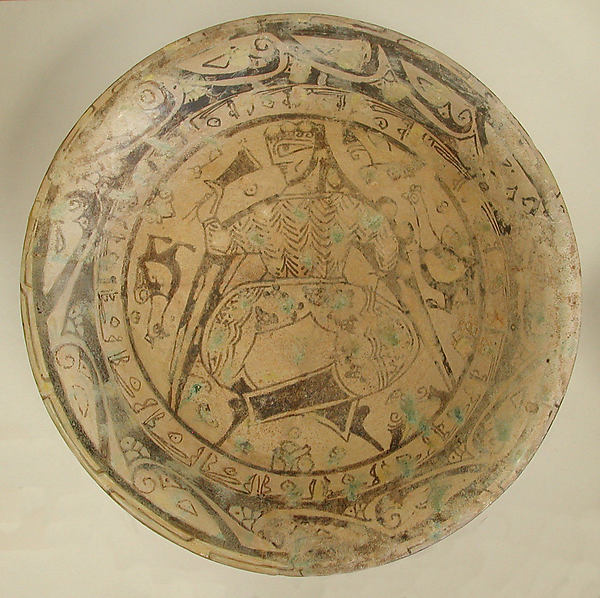Register a SNAP EBT card with Amazon

Amazon Audible Gift Memberships
Bowl with a Drinker, 8th-9th Century, Nishapur, Iran
Metropolitan Museum of Art, New York

A larger image of a bowl with a Drinker, 8th-9th Century, Nishapur, Iran, Metropolitan Museum of Art, New York.
Bowl
Date: late 8th-9th century
Origin: Nishapur, Iran
Culture: Islamic
Medium: Earthenware; buff slip, underglaze painted in polychrome pigments under a transparent glaze
Dimensions: Height 6.4 cm Diameter 22.5 cm Base: 9.2 cm
Classification: Ceramics
Accession Number: 40.170.14
Metropolitan Museum of Art, New York
64 BOWL
D 22.5, H 6.5 cm ; Tepe Madraseh
MMA 40.170.14
Buff body and surface. Glaze almost disintegrated.
Base, concave, has groove forming foot ring; it is covered with engobe and glaze.
Exterior decoration: joined curved brackets resembling those to be seen on 74.
On the interior the central figure is that of a man, his head in profile, drinking from a goblet.
Although the pose suggests that he is dancing, he is in truth seated.
This position, in which the legs form a lozenge shape, seems to be an adaptation of an early iconographical tradition.
The pose occurs on Bactrian coins. In Sasanian examples the space between the legs is not always present.
A silver plate of the sixth or seventh century, on which the figure represents a moon god,
shows the legs closely crossed, leaving no space (Pope, Survey IV, pl. 207 B).
On the other hand, figures more or less contemporary with the one on this Nishapur bowl were sometimes represented with their feet nearly touching but not crossing
(Lane, Early Islamic Pottery, pl. 13A).
The breeches of the man on 64, decorated with groups of connected circles, have, over each knee, a strange “patch” with double outline, decorated with crosses.
Such “patches” are not found on the breeches of Nishapur equestrian figures, only on those of seated figures.
The practice of changing the decoration from area to area, irrespective of their fundamental meanings,
is characteristic of this ware (compare 62, decoration of space between legging and stirrup strap).
The knee patches can be explained as a misunderstanding by the potters of older, more accurate images.
One of these correct versions, perhaps of the eighth century, occurs on a painted wooden votive tablet from Dandan Oiluq (Khotan),
in which the body garment of a cross-legged bodhisattva, partly concealed by an outer coat, reappears on his knees, just above his high boots
(M. A. Stein, Ancient Khotan II, Oxford, 1907, pl. LXI; M. Bussagli, Painting of Central Asia, Geneva, 1963, p. 57).
This representation would appear to conform to reality when a figure is so dressed and so posed.
In the tenth century, however, when their origin had been forgotten, the rounded or oval shapes between the boots and garments were decorated arbitrarily, as on 64.
One example among several of such patches in the buff ware of Nishapur occurs on a bowl in the Cleveland Museum
of Art (Wilkinson, Iranian Ceramics, pl. 26), where they appear on the breeches of two bearded men sitting crosslegged, as on 64, and with even less rationality,
on the skirts of two bearded men sitting on stools.
This confusion is paralleled on a gold medallion in the Freer Gallery, probably a Buwayhid piece,
on which a male figure has a decoration of concentric circles upon his knees (Bahrami in Archaeologica Orientalia in Memoriam Ernst Herzfeld, pl. la).
The head of the man on 64 is remarkable for its very large eye.
The lips, chin, cheekline, beard, forehead curls, and decorated hair are all reminiscent of the figure on 62.
A bifurcated scarf (compare 59) descends from either shoulder,
so drawn that there is confusion as to what is scarf and what is hair.
The scarf has an added decoration of rectangular forms in reserve, probably present simply to break up its black areas.
Two round curls (?) appear just below the man's left shoulder.
There is almost a suggestion that he wears a veil fastened to the back of his head.
Some figures on Abbasid luster ware have pointed caps with a long veil or scarf falling behind almost to the ground; however,
the relationship is not close enough to support a belief that the figure of 64 wears a veil.
The figure's tight-fitting shirtlike garment, with no opening visible in front, is decorated with a herringbone pattern.
His leggings and shoes resemble those of the figure on 62; see further comment there.
For comment on the possible significance of the lifted goblet, see 59.
The spaces around the figure are filled with a variety of ornamental motifs, lightly indicated, and two birds,
their bodies decorated with a version of the curled band also seen in
62 and 63.
Surrounding the central medallion is a band of pseudo Kufic, decorated with dot-centered circles.
This “inscription” is similar in style to the pseudo Kufic on other animate bowls
(73,
78,
87, 91)
and an inanimate piece (48).
At the rim of 64 is a band of black with a series of half-leaves in reserve, all of them placed above the stem, unlike the treatment of a similar decoration on 63.
Source, pp. 22-23 in Nishapur: Pottery of the Early Islamic Period by Charles K. Wilkinson
End: Bowl with figure and birds, 10th century, Nishapur, Eastern Persia. ex-Xavier Guerrand-Hermès Collection.
Next: Warrior wearing a pointed helmet and a studded shirt, east Persia or Transoxiana, 10th Century, Bonhams
Back to Bowls with figures from Nishapur, Kurasan, Iran, 9th-10th centuries, Saffarid-Samanid period
Other 8th Century Illustrations of Costume & Soldiers

